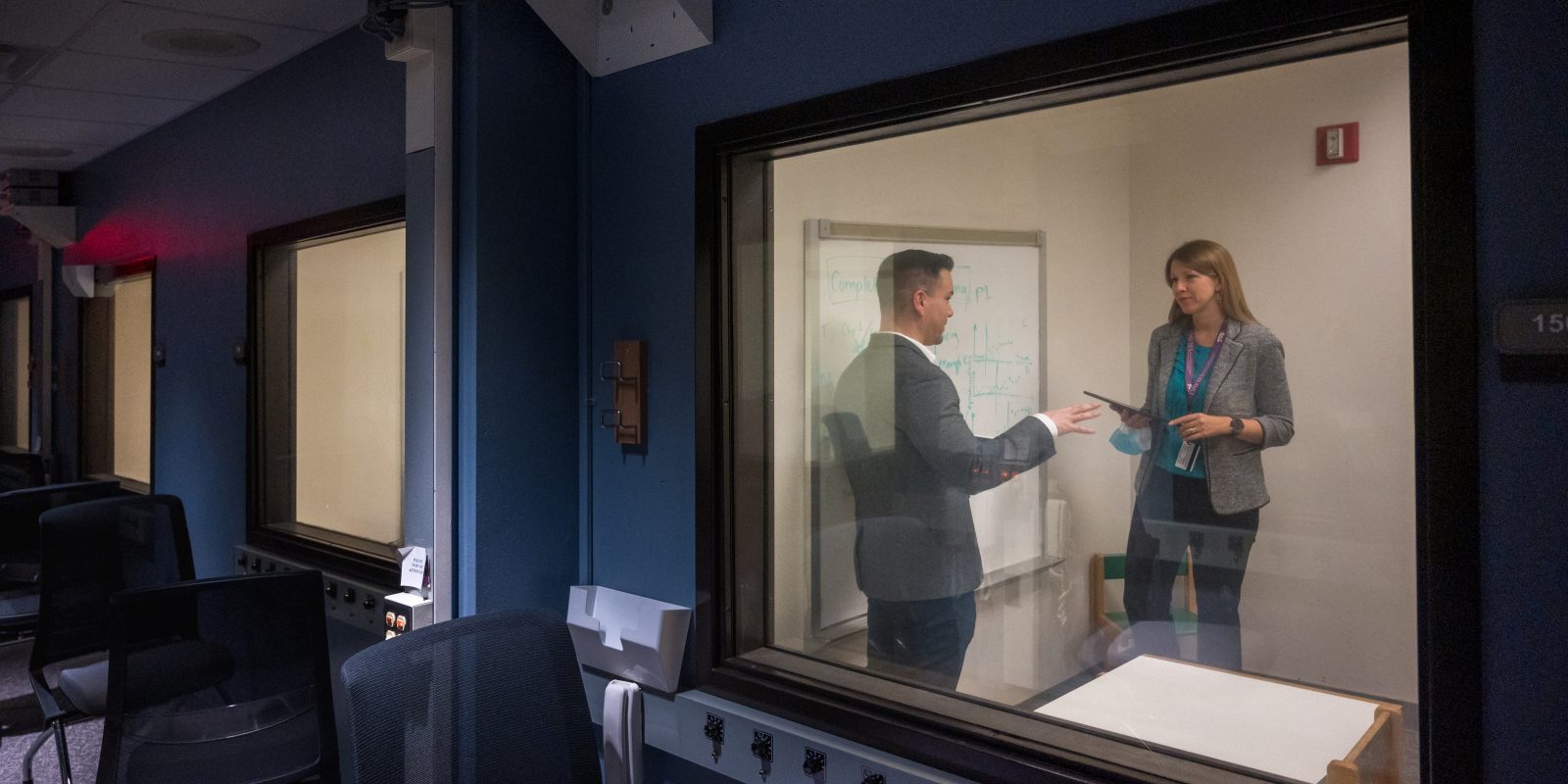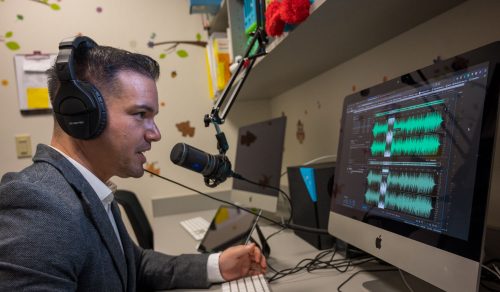
Emily Lund and Jean Rivera Pérez discuss their ongoing research into ways to harness technology for teaching early literacy skills to children with communication disorders. Photo by Leo Wesson
TV Shows Aid Dual-Language Learners
Emily Lund and Jean Rivera Pérez find kids’ programs can be effective language teaching tools.
When Emily Lund heard her 3-year-old say the words kinetic energy — a topic never discussed at home — she realized entertainment technology could indeed be an educational tool.

Emily Lund discusses ways to harness technology to help teach early literacy skills to children with communication disorders. Photo by Leo Wesson
“If you had asked me 10 years ago if I had any interest in thinking about the overlap of technology and language learning,” Lund said, “I would have said, ‘No, not interested.’ ”
Modern media often gets a bad reputation for causing developmental delays in young children, but Lund, an associate professor at the Davies School of Communication Sciences & Disorders, sees the opportunity for children to learn vocabulary and language skills in an entertainment context.
“I think it is really easy for television and technology to be demonized, especially in child development literature,” said Lund, also associate dean for research at the Harris College of Nursing & Health Sciences. “I started getting interested in how it can be harnessed and used.”
Lund partnered with Jean Rivera Pérez, an assistant professor in the Davies School, on two projects involving technology and language learning. Puerto Rico native Rivera Pérez said he intends to develop resources for Spanish-speaking and bilingual children with language disorders. “I decided to [better support] the Spanish-speaking Latinx community in the United States with research that feeds the needs of this population.”
Together they developed an app called Leyendo en Casa (Reading at Home) that English-speaking speech-language pathologists may use to educate parents in techniques to promote Spanish to their children with language disorders.
The professors then joined forces to investigate how technologies such as television programs or reading apps can help children who are learning a second language while also developing their native language. An indicator of how well children learn a language is the number of vocabulary words they are exposed to during their early years.

Jean Rivera Pérez investigates the use of technology in helping children learn a second language and expand their native tongue. Photo by Leo Wesson
The professors’ 2021 paper published in the Journal of Children and Media analyzes popular bilingual children’s television programs to determine which shows use educational strategies proven to help children learn words. Co-author Rachel Hart ’19 helped design a study using a coding system to analyze episodes of Dora the Explorer; Go, Diego, Go!; Maya & Miguel; Handy Manny; and Nina’s World.
School-age children learn approximately 3,000 to 4,000 new words a year through explicit cues, such as direct definitions, and implicit cues, such as visual images. Dual-language learners often speak different languages at home and in school, making it difficult to encounter enough words to promote both languages. They need additional exposure to both languages.
Hart, who recently earned a master’s degree in speech and hearing sciences at the University of North Carolina, Chapel Hill, transcribed the episodes and analyzed them for explicit cues, contextual cues and implicit cues. The goal was to determine which programs used the most effective instructional tools.
They scored Dora the Explorer and Go, Diego, Go! the best in terms of educational potential. Both programs used known vocabulary-learning techniques such as pausing to allow children to repeat a word or inserting a word in a jingle. The shows also incorporated cultural context, which Lund and Rivera Pérez said is an important part of learning a language.
A forthcoming paper from Lund and Rivera Pérez will investigate whether a language and literacy app based on discussion strategies can help Spanish-speaking parents teach their children language skills in Spanish and English.
While they wait for results, the professors said parents don’t need to feel guilty about encouraging a little screen time. “Obviously, everything in moderation,” Rivera Pérez said.
Lund said that TV allows for broad experiences and thus exposes children to more vocabulary. “Television is a great vehicle for expanding our world knowledge on all kinds of things and for using linguistic structures that I don’t typically use in my day-to-day interactions.”

Your comments are welcome
Comments
Related reading:
Research + Discovery
Understanding Literacy in Kids with Cochlear Implants
Even with hearing corrected, children may lag behind in language or reading comprehension.
Campus News: Alma Matters, Research + Discovery
Bilingual Speech Therapy for Stroke Survivors
A monthly bilingual support group at Miller Speech & Hearing Clinic offers hope for people working to regain the ability to speak.
Features
Hearing Problems? There’s an iPhone App for That
Computer scientist Liran Ma is developing a program to make an iPhone operate as an inexpensive hearing aid.